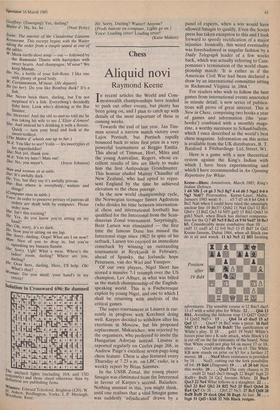Chess
Aliquid novi
Raymond Keene
In recent articles the World and Com- monwealth championships have tended to push out other events, but plenty has been going on, and I plan to catch up with details of the most important of these in coming weeks.
Towards the end of last year, Jan Tim- man scored a narrow match victory over Lajos Portisch, but Portisch rapidly bounced back to seize first prize in a very powerful tournament at Reggio Emilia. This ahead of Timman, Hort, Miles and the young Australian, Rogers, whose ex- cellent results of late are likely to make him the first Antipodean Grandmaster. This honour eluded Murray Chandler of New Zealand, who had opted to repre- sent England by the time he achieved elevation to the chess peerage. In the new world championship cycle, the Norwegian teenager Simen Agdestein (who divides his time between internation- al chess and international football) has qualified for the Interzonal from the Scan- dinavian Zonal tournament. Surprisingly, Bent Larsen was eliminated — the first time the famous Dane has missed the Interzonal stage since 1962! In spite of his setback, Larsen too enjoyed an immediate comeback by winning an outstanding tournament at Reykjavik in February, ahead of Spassky, the Icelandic hope Petursson, van der Wiel and Yusupov. Of our own players, Nigel Short has seored a massive 7-1 triumph over the US champion, Lev Alburt, in what was billed as the match championship of the English- speaking world. This is a Fischeresque exploit by young Nigel, and one to which I shall be returning with analysis of the critical games. The super-tournament at Linares is cur- rently in progress with Korchnoi doing well. Karpov decided to withdraw after his exertions in Moscow, but his proposed replacement, Makarichev, was rejected by the organisers, who preferred to invite the Hungarian Adorjan instead. Linares is reported regularly on Ceefax page 268, in Andrew Paige's excellent seven-page-long chess feature. Chess is also featured every Thursday at 7.23 a.m. on LBC radio, in a weekly report by Brian Sammes. In the USSR Zonal, the young player Smagin was eliminated from the Interzonal in favour of Karpov's second, Balashov. Nothing unusual in this, you might think, until one realises that a vital Smagin game was suddenly 'adjudicated' drawn by a
panel of experts, when a Win would have allowed Smagin to qualify. Even the Soviet press has taken exception to this and I look forward to speedy rectification of a major injustice. Ironically, this weird eventuality was foreshadowed in singular fashion by a Daily Telegraph leader of a few weeks back, which was actually referring to Cam- pomanes's termination of the world cham- pionship match: 'It is rather as if the American Civil War had been declared a draw by an international committee sitting in Richmond Virginia in 1864.'
For readers who wish to follow the best games from international events annotated in minute detail, a new series of publica- tions will prove of great interest. This is New in Chess, comprising two books a year of games and information (the 'year- books') combined with a monthly maga- zine, a worthy successor to Schaakbulletin, which I once described as the world's best chess magazine. Information on this series is available from the UK distributors, B. T. Batsford 4 Fitzhardinge Ltd, Street, W1 .
Here is a game with a new theoretical system against the King's Indian with which I have been experimenting and which I have recommended in An Opening Repertoire for White: Keene—Blees: Amstelveen, March 1985; King's Indian Defence.
1 d4 Nf6 2 c4 g6 3 Nc3 Bg7 4 e4 d6 5 Nge2 0-0 6 Ng3 Nc6!? Provocative. Keene-Lauri, Malta, January 1985 went: 6. . . e5 7 d5 c6 8 h4 0b69 Be2 Na6 when I could have tried the amazingly unclear line 10 Be3!? Qxb2 11 Na4 Qa3 12 Bel Qb4+ 13 Bd2 Qa3 14 Nf5! gxf5 15 Rh3 Qxh3 16 gich3 Nxe4, when Black has distinct compensa- tion for the 0.7 d5 Ne5 8 Be2 c6 9 f4 Ned7 10 Be3 h5. Considerably more combative than 10 . . . cxd5 11 exd5 a5 12 0-0 Nc5 13 f5 Bd7 14 Qd2 Keene-Jassem, Dubai 1984, when all Black can do is sit and watch. 11 h3 Nc5 12 Bf3 Inviting Position after 19 Bd4
adventures. The sensible course is 12 Bxc5 dxc5
13 e5 with a solid plus for White. 12. . . Qb6 13 Rbl. Avoiding the hideous trap 13 0d2? Qxb2!
14 Qxb2 Nd3+. 13 . . . Qb4 14 e5 dxe5 15 a3 Qa5 15 . . . Qxc4? 16 Be2 wins a piece. 16 fxeS Nfd7 17 0-0 Nxe5 18 Bxh5! The justification of White's play. If 18 . . . gxh5 19 Nxh5 White's forces pour into a K-side attack, while Black's 0 is cut off on the far extremity of the board. Note that White could not play b4 on move 17 or 18, since . . . Qxa3 attacks the N on c3. The White KB now stands en prise on h5 for a further 12 moves. 18. . . Nxc4 More resistance is provided by 18 . . . Ncd3, cutting out the fork possibility of b4. 19 Bd4 (Diagram) 19. . . e5 20 b4! Now this works. 20 . . . Qxa3 The only chance is 20 . . . exd4 21 bxa5 dxc3 though 22 Bxg6! fitg6 23 Rxf8+ Bxf8 24 Qc2 favours White. 21 BxcS Qxc3 22 Ne4 What follows is a slaughter. 22. . . Qa3 23 Ral Qb2 24 Rf2 Ne3 25 Bxe3 Qxb4 26 Ra4 Qe7 Or 26. . . Qb5 27 Nc3. 27 Bc5 Qd8 28 Bx18 MEM 29 dxc6 Qb6 30 Bxg6 At last. 30 . . . fxg6 31 Qc15 Kh8 32 N16 Black resigns.


















































 Previous page
Previous page